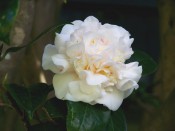Camellias at Camden Park
Cultivars of Camellia japonica are highly variable in size and habit and are often capable of growing into small trees. The first camellia to be imported into England, in 1739, had single red flowers and was figured in Curtis’s Botanical Magazine [BM t.42/1788]. There was a trickle of introductions in the late 18th and early 19th centuries, all from China, primarily via the British East India Company. Sixteen varieties were listed by the Botanical Register in 1822 [BR f.633/1822]. Most of these were grown at Camden Park:
Single red Camellia. Curtis’s magaz. 42.
Semi-double red Camellia. Andrews’s reposit. 559.
Double red Camellia. Andrews’s reposit. 199. [See Camellia japonica L. var. rubra plena].
Middlemist’s red Camellia. [See Camellia japonica L. var. carnea Ker].
Myrtle-leaved red Camellia. Curtis’s magaz. 1670. [See Camellia japonica L. var. myrtifolia].
Anemone-flowered, or Warrata’h Camellia. Curtis’s magaz. 1654. [See Camellia japonica L. var. anemoniflora].
Peony-flowered Camellia. Andrews’s reposit. 660. fig. 1. [See Camellia japonica L. var. peoniflora rubra and paeoniflora pallida].
Double-striped Camellia. Andrews’s reposit. 91. [See Camellia japonica L. var. variegata].
Blush (or Lady Amelia Hume’s) Camellia. Supra vol. 2. fol. 112. [See Camellia japonica L. var. incarnata].
Buff Camellia. [See Camellia japonica L. var. incarnata].
Double white Camellia. Andrews’s reposit. 25. [See Camellia japonica L. var. alba plena].
Pompone Camellia. Supra vol. 1. fol. 22. [See Camellia japonica L. var. ‘Pompone’].
Single white Camellia. Supra vol. 5. fol. 353. [See Camellia Japonica L. var. alba simplex].
Lady Long’s Camellia. Supra. [Probably the same as Camellia japonica L. var. myrtifolia which see].
Hexangular red Camellia. [May be the same as Camellia japonica L. var. rubra plena which see].
Red-stalked Camellia.
Don gives a similar list for a decade later, with quite detailed descriptions. From this date there was a very rapid increase in the number of named cultivars bred and introduced, in Europe in particular but increasingly in North America and European colonies, notably Australia.
Many of the cultivars described in the Hortus were bred at Camden Park by William Macarthur and descriptions of these are taken from his own notes, dating from the period 1850-1852 when most of the seedlings first flowered. [MP A2948-6]. Macarthur grew more than 800 seedlings in the 1840s, 62 of which he considered distinctive enough to be named. The Camden Park-bred plants have a number appended, taken from his notebook; for example ‘Aspasia’, the first listed in the notebooks and the first added to the catalogues in 1850, is number 1/50, seedling 1 of 1850. Unfortunately Macarthur left no record of the cultivars he used to produce his seedlings but it seems likely that ‘Anemoniflora’ featured among the seed parents. This pollen-sterile variety was extensively used at this time because no precautions needed to be taken to prevent self-pollination.
Most of Macarthur’s cultivars are listed in the International Camellia Register, some with a description. The exceptions are noted in their respective entries. The names of many of Macarthur’s cultivars were first listed in the Australasian Botanical and Horticultural Society Report of 1849/50 in a table of plants introduced to the colony during the year 1849-50, but without descriptions.
In the 1930s the Sydney nurseryman Walter Hazlewood visited Camden Park to identify surviving Camellias. He reported that 107 plants were still alive of which about 15 were labelled, although not always correctly. He believed that in some cases the stock on which they had been grafted had grown up and replaced the grafts. Hazlewood reported that ‘a total of 64 have been identified and a number of others look like Camden Park seedlings, but the data available is not enough for correct determination.’ [SOURCE].
Today most of the plants identified by Hazlewood have perished and only a handful of camellias survive at Camden Park, including a tree of Camellia japonica ‘Anemoniflora’, the ‘Waratah camellia’, believed to be the oldest camellia in Australia. This has been dated to 1835 but is probably a few years older as the records show that a plant of this name was received per the ‘Sovereign’ in February 1831. [MP A2948]. Fortunately a small number of Macarthur’s cultivars have survived. A handful are still sold by nurseries and one, the beautiful ‘Aspasia’, is quite commonly grown around the world. A number of Macarthur’s cultivars were located outside Camden Park by Hazlewood and Waterhouse in the 1930s and 1940s and described in Waterhouse’s Camellia Quest. Many camellias were distributed around Australia from the Camden Park nursery and it may still be possible to locate and revive yet more cultivars. Identifying and recovering these old varieties is a major project of the Camden Park Nursery Group and has already had considerable success. The project leader is Jim Lykos.
The Nursery Group has had considerable success in locating old cultivars and has propagated many by cutting and graft. We have also been successful in transplanting a number of 40 year old trees.
Information on the location of any of the cultivars listed in the Hortus will be gratefully received.


